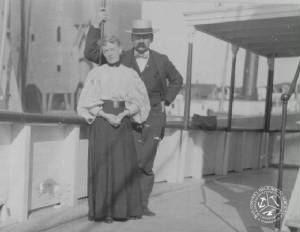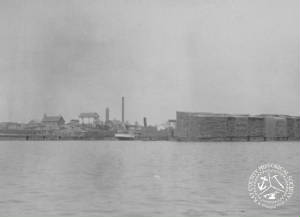by David K Hohenstein

Object Source: Bay County Historical Society
On the Artist
The
Bay County Historical Museum holds in its collection a series of paintings by the maritime artist Howard Freeman Sprague.
Known as “The Boutell Fleet”, the Captain Benjamin Boutell commissioned this series of paintings around the year
1890 from the young and aspiring artist. The collection was donated to the museum by Boutell’s great grandson, William
Boutell, in 2006. They depict single ships or groups of ships on the Great Lakes, all of which once belonged to Captain Ben
Boutell.
The artist, Howard F. Sprague was from Huron, Ohio and born in 1871. He was among a handful
of known artists from the time period who focused their painting and drawing subjects almost exclusively on ships; more specifically
to the ships of the Great Lakes Region. In his youth he received some artistic training, but apparently did not stay long
in the academic setting.
His technical skill as an oil painter is apparent in his portrait of the
“Charlton”. This painting is neither dated or signed but is attributed to the year 1891, and is one in a series
of paintings by the artist in the museum collection dated from around the same time. Compared to some of his contemporaries,
Sprague is regarded as a more artistic painter within the genre. In this painting he not only captures a realistic and precise
representation of the Charlton but also recreates the atmosphere and energy of the Saginaw Bay.
Known
among sailors as a graveyard for vessels, the Bay could be treacherous to navigate in stormy weather due to its shallow waters
and frequently shifting sandbars. Sprague proficiently painted the water of the Bay in swelling waves of green that break
in misty foam against the side of the ship. The windswept skies are captured in speedy strokes of color that become like clouds
and air as the tug churns forward through choppy water. This ship would have traversed the many long miles between Canada
and Michigan, back and forth over and again, towing millions of feet of timber on its journeys.
The
Artist may have had a fascination with painting ships, or perhaps it was the demand of a market that dictated his narrow focus.
In any case, it is inarguable that he possessed both talent and skill in his work and seems to have seen some fruit for his
labors. Not only did he receive and complete commissions, such as for the Captain Boutell, his paintings were also published
in St. Nicholas Magazine, New York Magazine, and Harper’s Magazine.
Eventually
Howard did leave the Great Lakes, and was recognized for his contributions to ship painting, illustration and lakeside scenes.
He once painted a ship from the east coast, La Grande Duchesse, around 1898 and traveled as far as Puerto Rico. This
resulted in an unfortunate early end to his life as he contracted tuberculosis on the trip and later died in Buffalo, New
York. Howard was only twenty eight years old. His work has outlasted him, having a home in this museum as well as other collections
across the country. Apart from his paintings, there is scarce documentation of his life, and this artist’s
dreams and inner world seem to have been left largely unrecorded, perhaps unrealized.
The paintings
record the accomplishments of another man, one for whom there is much more to say. The story of the life of Benjamin Boutell
is one of considerable interest as he was a man of outstanding character and accomplishment; one who seems to have lived fully
and from his heart.
Captain Benjamin Boutell, Life and Career

Image: Amelia and Benjamin Boutell. Source: Bay County Historical Society.
Born
to Betsy Adams, descendant of President Adams, and Daniel Boutell from Syracuse New York, he began his working life early
on at the age of six on a farm his parents owned in Deerfield Township, Michigan. He was reared and worked in the fields as
a young boy. By the time he was twelve his parents moved to Birch Run before settling in Bay City, leaving Benjamin in charge
of the family farm for some time. In Bay City the Boutells purchased a property and opened a hotel, naming it The Boutell
House. Before then the fledging city was only a village. It was known as “Lower Saginaw” because the Saginaw
River flows north into the Bay. The name changed to Bay City in 1857, two years before the Boutells opened their hotel.
For six years they ran their hotel as the population they served grew around them, but their fates changed
in the winter of 1865 when the Boutell House caught fire and burned down. Daniel fought the fire during the night
but could not stop it. The incident led him to develop pneumonia and he was unable to fully recover from the illness. He died
only a few years later.
During the early years of Bay City, in the latter half of the 19th
century, the settlement grew from a village into a lumbering epicenter of the Great Lakes region. The abundance of natural
resources are to credit for the monetary wealth that was generated here. Timber was, of course, the product and the water
was a main passageway. Thus, the lumbering and maritime industries grew simultaneously.
The young
Benjamin Boutell began what became his lifelong career as a wheelman of the tugboat “Wave”. Within a year he was
promoted to mate of the “Wave”. Following, he began captaining a previously docked vessel, “the Ajax”
and with a crew of two persons. They hauled and split lumber themselves, working hard and earning the owners of the vessel
a profit of around $6,000 in their first year.
In 1869, Captain Boutell partnered with the Captain
William Mitchell and together they pulled lumber from Pinconning to the sawmills in Bay City and Saginaw with a tug boat called
“Union”. Their union lasted almost seventeen years during which time the population of Bay
City nearly doubled from 15,820 in 1870 to 29,415 people by 1884. The lumbering industry drew many settlers and seasonal workers
to Bay City, and it was during this time when some of the historic buildings still standing went up and debauchery ran rampant
in the city’s notorious “Hell’s Half Mile”.
When the Captains dissolved
their partnership and went separate ways Boutell took along with him the tug and towing boats.
Captain
Boutell’s enterprises continued to grow, as did his influence and affiliations. In 1888 he joined with another business
partner, Captain P.C. Smith to form the Saginaw Bay Towing Association. Together they compiled one of the largest and most
successful tug fleets on the Great Lakes. It was around this time that Ben acquires the vessel “Charlton” as featured
in Howard Sprague’s painting. The Charlton was 120 feet in length (a large size for a tug boat) and was used to pull
logs across the lakes between U.S. and Canadian territories.
 Image: Georgian Bay, Canada. Source: Bay County Historical Society
Image: Georgian Bay, Canada. Source: Bay County Historical Society
During the busiest season of
the year the Saginaw Bay Towing Association would employ up to around 600 workers and moved 1,000,000,000 to nearly 4,000,000,000
feet of timber annually. At the time, Captain Boutell was credited for moving more lumber than any other living man. Boutell
organized another towing company under his name in Boston, Massachusetts and was also highly invested in local and far reaching
sugar manufacturing. Bay City is known for its beet sugar processing plant and production. The unique smell produced is characteristic
of the area. Captain Boutell played a major role in starting the Michigan Sugar Company and the Bay City Sugar Company (among
many others) of which he was a stockholder and vice president respectively. He even continued farming, buying a plot of land
in Essexville to raise produce, grain and animals though Boutell Farm was not a business endeavor.
As
immigrant settlement expanded further west across the continent, the need for raw building materials greatly increased. Michigan’s
prime forests and waterways were utilized to supply and transport massive quantities of lumber throughout the region and across
the greater country. Hundreds of sawmills operated in great Michigan, least of none in Bay City. Logging
companies first cleared forests in Michigan near waterways but the extension of railways allowed loggers to move timber an
even greater distance and harvest more and more trees without regulation. The same means that built America as a country also
exploited the environment, forever changing its landscape and ecosystems. Vast forests that were hundreds
of years old were leveled within fifty years, thus ending Michigan’s lumbering era.
Boutell
and Family
The picture painted of Boutell’s character though, is overwhelmingly positive.
He was compassionate, driven, playful, ambitious, generous and loving. He was a well respected, outstanding citizen
and directly involved in the formation and funding of Bay City’s Mercy Hospital, the Madison Avenue
Methodist Church, the YMCA and YWCA. In 1869 he married the young Amelia Duttlinger who was originally from Cleveland, Ohio.
He brought her to Bay City and had a house built for her in 1893. There they lived and raised two sons, Frederick and William.
Amelia’s twin sister Cornelia also moved in with the family and the two are reputed to have been inseparable yet opposite
temperaments. Mr. Boutell is quoted in an 1894 article from the Bay City Times, after the reporter points out he seemed happy,
saying “Yes, no one enjoys life more than I do, for I do not worry myself to death. If there is to be an earthquake,
let it come.”
Amelia Boutell developed cancer in her middle-age and despite the family seeking
the best available care for her condition, the disease eventually took her over. On her deathbed she asked her husband to
promise to marry her sister, and not any other woman. This was perhaps to secure the inheritance of the family fortune to
her sons and assure that Cornelia would continue to be taken care of. While Cornelia was known to be ill-tempered, Boutell
agreed to his wife’s wish and abided by it. Amelia Boutell passed at the age of fifty in 1902 and was mourned by many
who loved her. Captain Benjamin Boutell later passed in 1912, following an accidental injury sustained while trying to board
a moving train. He was sixty-nine years old.
The Captain’s legacy continues in memory and
in stories retold. His life and influence have shaped Bay City and the history of Michigan in ways that continue to this day.
Though the boom of the lumber era is long gone, much of the architecture and from that time remains a fixture of the City
today. Several generations of Boutell descendants have continued to live on in Bay City, helping in shaping their own time
in their own ways.
Sources:
Bay County Historical
Museum Archives: Boutell Photo Collection
Sibert, Thomas. “Architectural Accuracy and the Artists – Summer 1974, An
Introductory Study of Great Lakes Ship Portraiture.” National Museum of the Great Lakes.
1974. https://nmgl.org/architectural-accuracy-and-the-artists-summer-1974/
Konwinski, Mark. “The Impact of Lumbering and Railroads in Early Michigan.”
Mid Michigan Remembers Stories About Us. http://websites.delta.edu/michiganremembers/stories/Impact%20of%20LumberingKonwinski.htm
michiganhistory.org “A Brief History of Lumbering
in Michigan.” Center for Michigan History Studies.
http://www.michigan-history.org/lumbering/LumberingBriefHistory.html



 Image: Georgian Bay, Canada. Source: Bay County Historical Society
Image: Georgian Bay, Canada. Source: Bay County Historical Society


